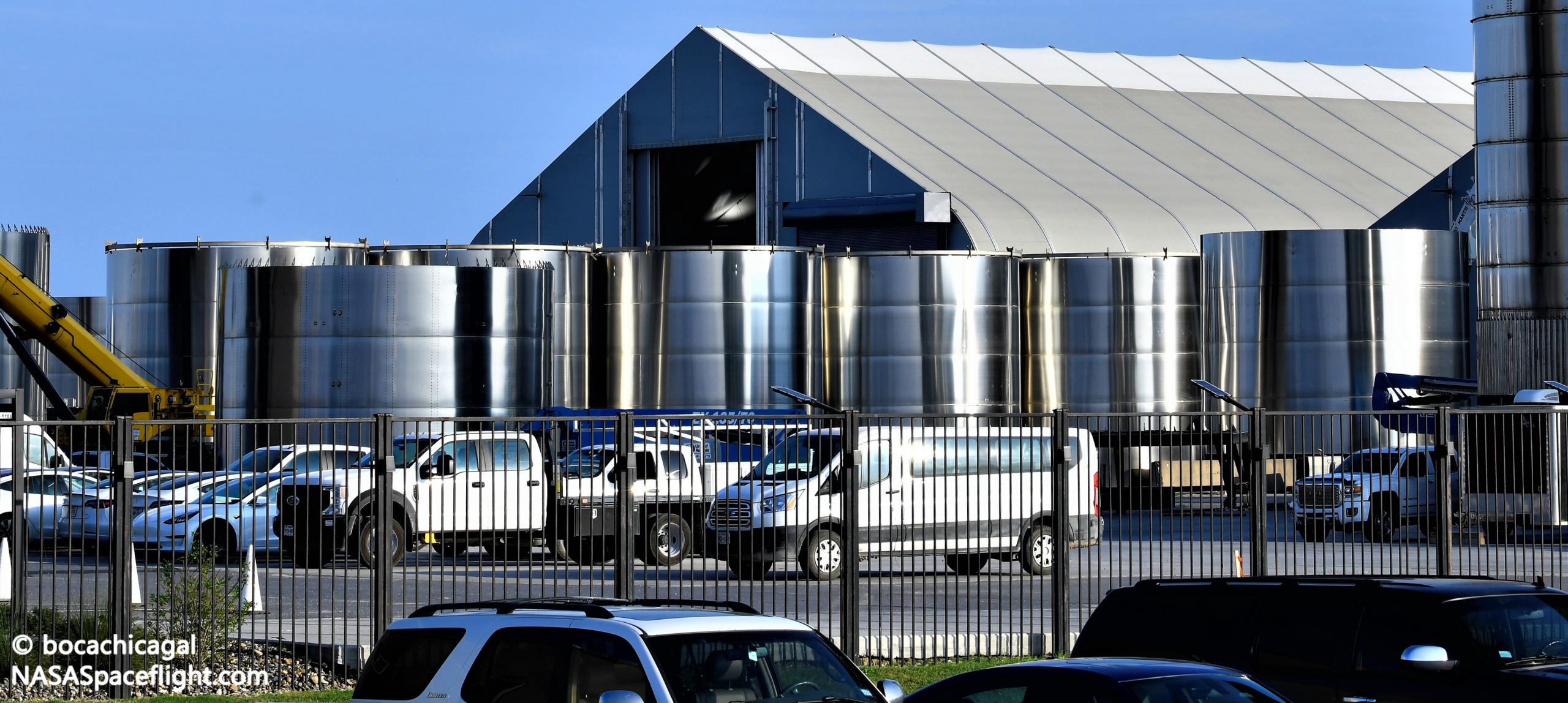

News
SpaceX Starbase construction takes priority as next orbital Starship, Super Heavy pair come together
As SpaceX teams slowly prepare the first orbital-class Starship and Super Heavy booster for the next-generation rocket’s first full-stack launch, the company has simultaneously begun assembling a second ship/booster pair. However, it’s clear that orbital pad construction remains a priority.
Known as Ship 20 and Booster 4, the two stages of the first orbital-class Starship first arrived at the launch site in early August. Only eight weeks later has Starship S20 finally become the first of the pair to attempt and complete one of two crucial proof tests, opening the door for one or several Raptor static fires in the coming week or two. Meanwhile, Booster 4 has had all 29 of its Raptor engines installed, uninstalled, and reinstalled and twice been placed on and removed from Starbase’s orbital launch mount in the same time frame but has yet to attempt any proof testing.
Despite the apparent delays and challenges slowing Ship 20 and Booster 4’s test debuts and two plodding FAA reviews that appear all but guaranteed to preclude an orbital launch attempt in 2021, though, SpaceX has recently begun assembling a second two-stage Starship.
Save for Starhopper back in 2019, no Starship or Super Heavy prototype has spent nearly as long at the launch site without a single test as Ship 20 and Booster 4 have. To an extent, there have likely been some technical delays while assembling, outfitting, and working with two first-of-their-kind prototypes. Still, the difference between past vehicles like Starship SN15 and Super Heavy Booster 3 are so stark that some portion of the testing delays almost has to be a conscious decision made by SpaceX.
To be able to fully proof and static fire test Super Heavy B4, SpaceX first needs to plumb, wire, and outfit Starbase’s orbital launch mount and complete a majority of the orbital pad’s massive tank farm. However, the orbital pad and its many unfinished systems are situated just a thousand (~300m) east of the suborbital launch site and Starship test facilities, which are complete and ready for testing. To test a Starship at those facilities, SpaceX has to entirely clear the pad of personnel – now several hundred people at the peak of construction – for 6-12+ hours.
The implication is that SpaceX management effectively chose to rip off the bandage now rather than later, sacrificing timely testing of Starship S20 to allow a near-total focus on orbital pad construction and activation over the last ~8 weeks. It’s hard to say if that’s paid off but the fact that SpaceX has chosen this particular moment to begin assembling the next orbital-class Starship and Super Heavy suggests that a clearer plan is starting to come together.
B4/S20, meet B5/S21
Parts of Starship S21 and Super Heavy B5 have been floating around Starbase’s build site for weeks. There was a multi-week period, for example, where the site’s massive high bay was effectively unused – clearly a conscious choice given SpaceX’s history of Starship prototype production earlier this year and late last. Parts of Super Heavy B5 were likely ready for assembly (i.e. stacking) by mid to late August. The ‘mid bay’ used for Starship tank section assembly has been similarly underutilized for even longer – only recently accepting its first Starship S21 section after supporting assembly of the orbital pad’s final storage tank.
Instead, Booster 5 stacking began around September 15th. At the current rate of assembly, which has slowed down considerably in the last week, SpaceX’s second flightworthy Super Heavy could reach its full 69m (~225 ft) height as early as mid-October. Starship S20 likely won’t be far behind. Further, thanks to SpaceX’s preferred style of continuous improvement, Booster 5 and Ship 21 production already appear well on track to outpace Booster 4 and Ship 20. With B5, rather than installing a range of external equipment (avionics, wiring, plumbing) after assembly is finished, SpaceX appears to be completing some of those subsystems during stacking, potentially speeding up final assembly by 1-2+ weeks. With S21, SpaceX has begun outfitting the Starship’s nose cone with heat shield tiles far earlier in the assembly process than it did with S20.
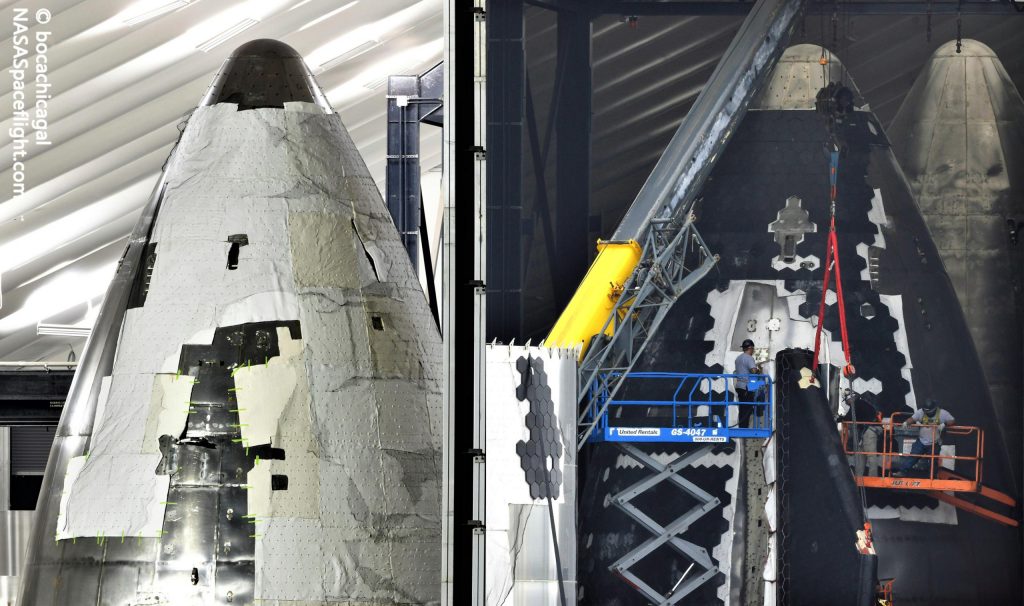
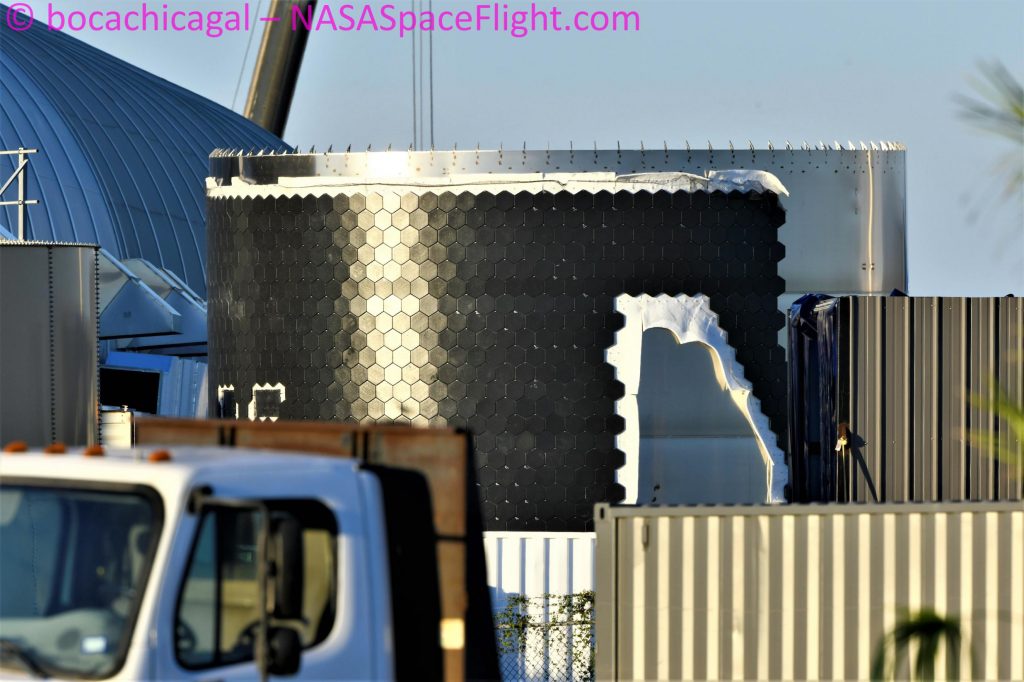
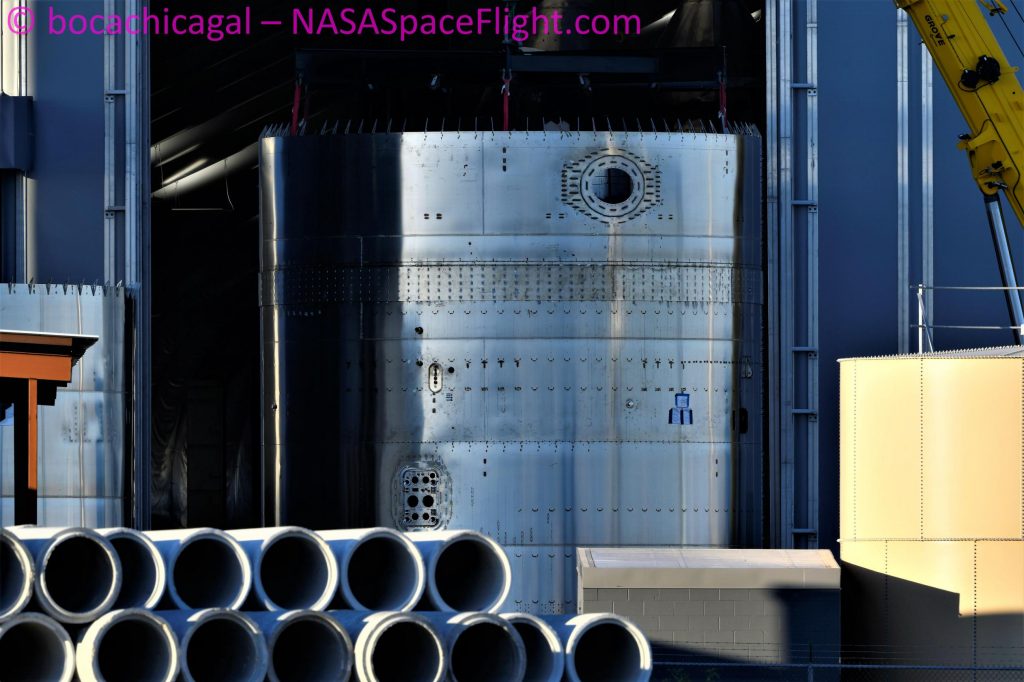
Given that it has taken SpaceX the better part of a month to finish and spot-fix Starship S20’s heat shield since the prototype’s second trip to the test site, taking those lessons learned to heart and getting Starship S21’s heat shield installation right on the first try could cut weeks from final assembly.
In the meantime, after completing Ship 20’s first cryoproof test on September 29th, SpaceX will hopefully be able to kick off the first six-engine Raptor static fire test campaign within the next week or so. With any luck, the start of B5/S21 assembly also means that the orbital launch pad is nearly ready to support Super Heavy B4’s first proof tests, even if static fires with anything close to a full set of 29 Raptors appear to be weeks away. Regardless, it looks like it won’t be long before SpaceX will be juggling two pairs of orbital-class Starships and Super Heavy boosters.

News
SpaceX shades airline for seeking contract with Amazon’s Starlink rival

SpaceX employees, including its CEO Elon Musk, shaded American Airlines on social media this past weekend due to the company’s reported talks with Amazon’s Starlink rival, Leo.
Starlink has been adopted by several airlines, including United Airlines, Qatar Airways, Hawaiian Airlines, WestJet, Air France, airBaltic, and others. It has gained notoriety as an extremely solid, dependable, and reliable option for airline travel, as traditional options frequently cause users to lose connection to the internet.
Many airlines have made the switch, while others continue to mull the options available to them. American Airlines is one of them.
A report from Bloomberg indicates the airline is thinking of going with a Starlink rival owned by Amazon, called Leo. It was previously referred to as Project Kuiper.
American CEO Robert Isom said (via Bloomberg):
“While there’s Starlink, there are other low-Earth-orbit satellite opportunities that we can look at. We’re making sure that American is going to have what our customers need.”
Isom also said American has been in touch with Amazon about installing Leo on its aircraft, but he would not reveal the status of any discussions with the company.
The report caught the attention of Michael Nicolls, the Vice President of Starlink Engineering at SpaceX, who said:
“Only fly on airlines with good connectivity… and only one source of good connectivity at the moment…”
CEO Elon Musk replied to Nicolls by stating that American Airlines risks losing “a lot of customers if their connectivity solution fails.”
American Airlines will lose a lot of customers if their connectivity solution fails
— Elon Musk (@elonmusk) December 14, 2025
There are over 8,000 Starlink satellites in orbit currently, offering internet coverage in over 150 countries and territories globally. SpaceX expands its array of satellites nearly every week with launches from California and Florida, aiming to offer internet access to everyone across the globe.
Currently, the company is focusing on expanding into new markets, such as Africa and Asia.
News
Tesla Model Y Standard stuns in new range test, besting its Premium siblings
Tesla’s newer vehicles have continued to meet or exceed their EPA estimates. This is a drastic change, as every 2018-2023 model year Tesla that Edmunds assessed did not meet its range estimates.
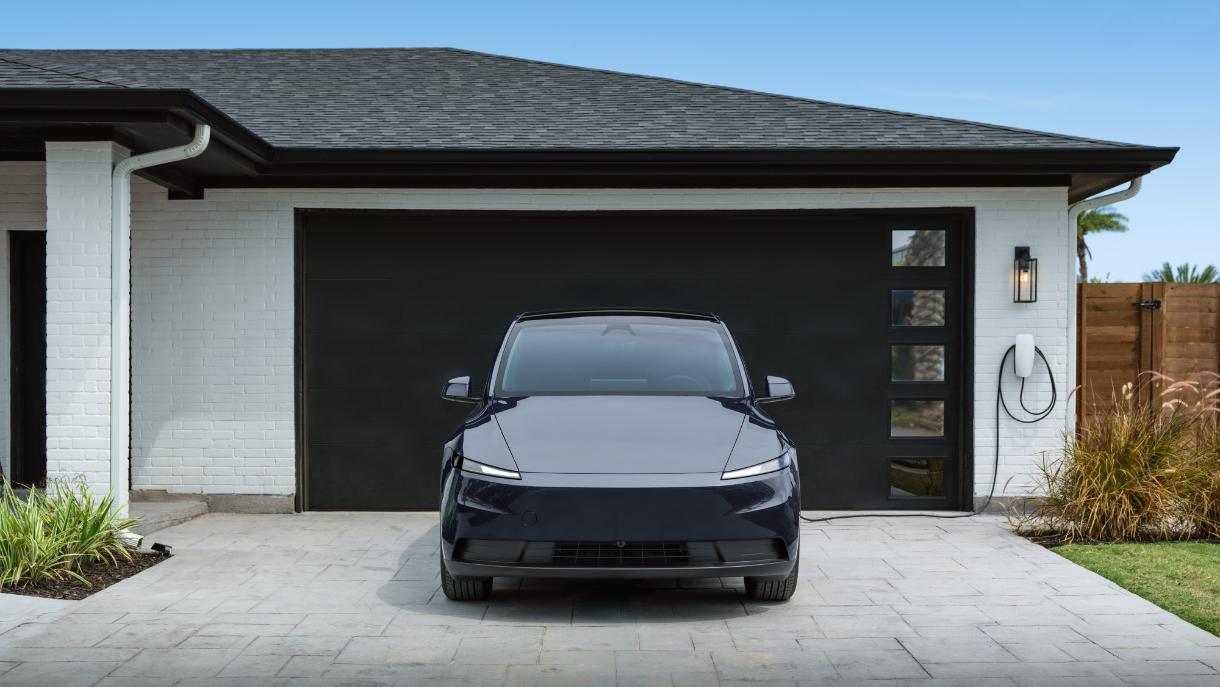
The Tesla Model Y Standard stunned in a new range test performed by automotive media outlet Edmunds, besting all of its Premium siblings that are more expensive and more luxurious in terms of features.
Testing showed the Model Y Standard exceeded its EPA-estimated range rating of 321 miles, as Edmunds said it is the “longest-range Model Y that we’ve ever put on our loop.” In the past, some vehicles have come up short in comparison with EPA ranges; for example, the Model Y’s previous generation vehicle had an EPA-estimated range of 330 miles, but only drove 310.
Additionally, the Launch Series Model Y, the first configuration to be built in the “Juniper” program, landed perfectly on the EPA’s range estimates at 327 miles.
It was also more efficient than Premium offerings, as it utilized just 22.8 kWh to go 100 miles. The Launch Series used 26.8 kWh to travel the same distance.
It is tested using Edmunds’ traditional EV range testing procedure, which follows a strict route of 60 percent city and 40 percent highway driving. The average speed throughout the trip is 40 MPH, and the car is required to stay within 5 MPH of all posted speed limits.
Each car is also put in its most efficient drive setting, and the climate is kept on auto at 72 degrees.
“All of this most accurately represents the real-world driving that owners do day to day,” the publication says.
With this procedure, testing is as consistent as it can get. Of course, there are other factors, like temperature and traffic density. However, one thing is important to note: Tesla’s newer vehicles have continued to meet or exceed their EPA estimates. This is a drastic change, as every 2018-2023 model year Tesla that Edmunds assessed did not meet its range estimates.
Tesla Model Y Standard vs. Tesla Model Y Premium
Tesla’s two Model Y levels both offer a great option for whichever fits your budget. However, when you sit in both cars, you will notice distinct differences between them.
The Premium definitely has a more luxurious feel, while the Standard is stripped of many of the more premium features, like Vegan Leather Interior, acoustic-lined glass, and a better sound system.
You can read our full review of the Model Y Standard below:
Tesla Model Y Standard Full Review: Is it worth the lower price?
News
Xpeng CEO: Tesla FSD 14.2 has developed “near-Level 4” performance
While acknowledging that imperfections remain, the Xpeng CEO said FSD’s current iteration significantly surpasses last year’s capabilities.

Xpeng CEO He Xiaopeng has offered fresh praise for Tesla’s Full Self-Driving (FSD) system after revisiting Silicon Valley more than a year after his first hands-on experience.
Following extended test drives of Tesla vehicles running the latest FSD software, He stated that the system has made major strides, reinforcing his view that Tesla’s approach to autonomy is indeed the proper path towards autonomy.
Tesla FSD closing in on Level 4 driving
During his visit, He test-drove a Tesla equipped with FSD V14.2. He also rode in a Tesla Robotaxi. Over roughly five hours of driving across Silicon Valley and San Francisco, He said both vehicles delivered consistent and reassuring performance, a notable improvement from his experience a year earlier.
According to He, Tesla’s FSD has evolved from a smooth Level 2 advanced driver assistance system into what he described as a “near-Level 4” experience in terms of capabilities. While acknowledging that imperfections remain, the Xpeng CEO said FSD’s current iteration significantly surpasses last year’s capabilities. He also reiterated his belief that Tesla’s strategy of using the same autonomous software and hardware architecture across private vehicles and robotaxis is the right long-term approach, allowing users to bypass intermediate autonomy stages and move closer to Level 4 functionality.
He previously tested Tesla’s FSD V12.3.6 and Waymo vehicles in California in mid-2024, noting at the time that Waymo performed better in dense urban environments like San Francisco, while Tesla excelled in Silicon Valley and on highways.
Xpeng’s ambitious autonomy roadmap and internal challenge
The Silicon Valley visit also served as a benchmark for Xpeng’s own autonomy ambitions. He stated that Xpeng is looking to improve its VLA autonomous driving system to match the performance of Tesla’s FSD V14.2 within China by August 30, 2026. Xpeng is poised to release its VLA 2.0 smart driving software next quarter, though He cautioned that the initial version will not be able to match FSD V14.2’s capabilities, as noted in a CNEV Post report.
He also added a personal twist to the goal, publicly challenging Xpeng’s autonomous driving team. If the performance target is met by the 2026 deadline, the CEO stated that he will approve the creation of a Chinese-style cafeteria for Xpeng’s Silicon Valley team. If not, Liu Xianming, head of Xpeng’s autonomous driving unit, has pledged to run naked across the Golden Gate Bridge, He noted.








